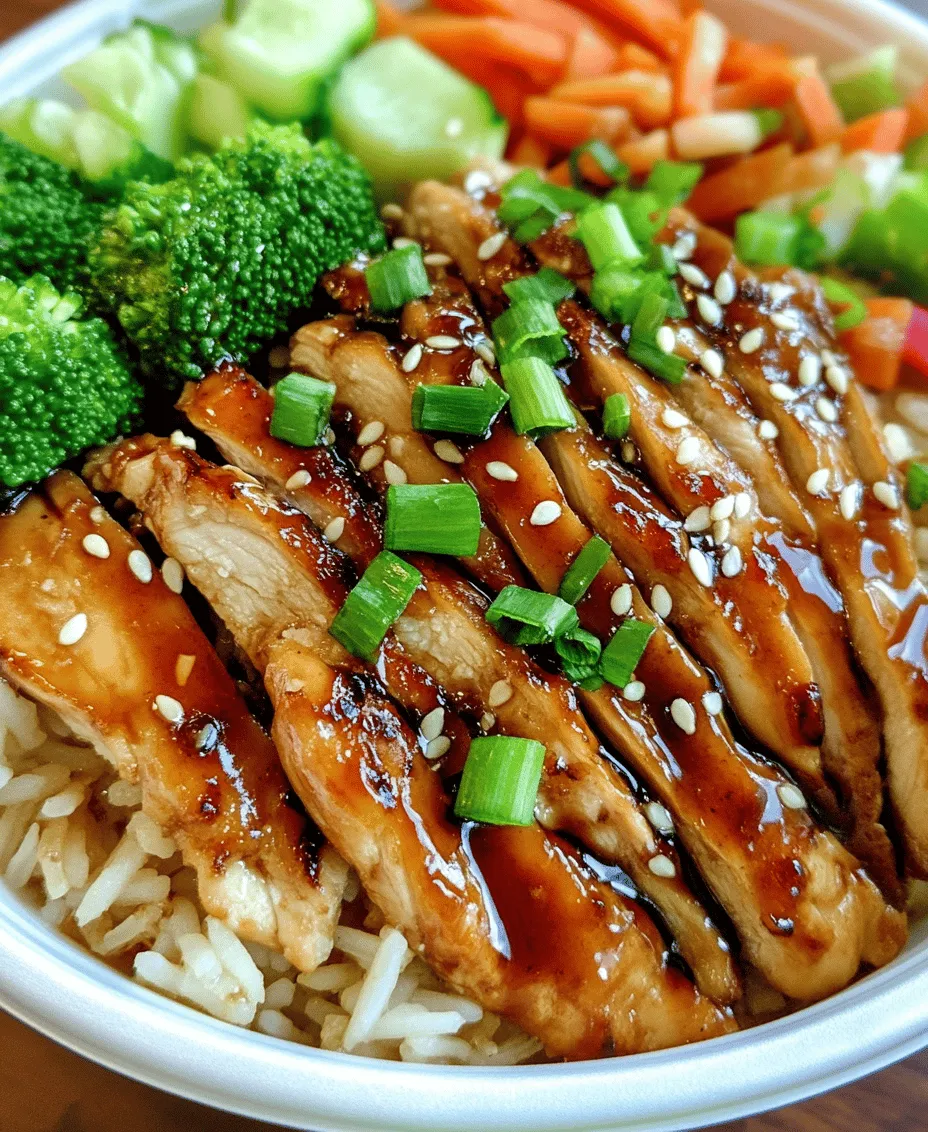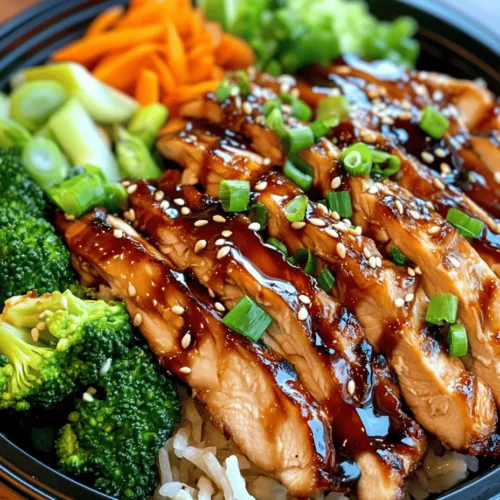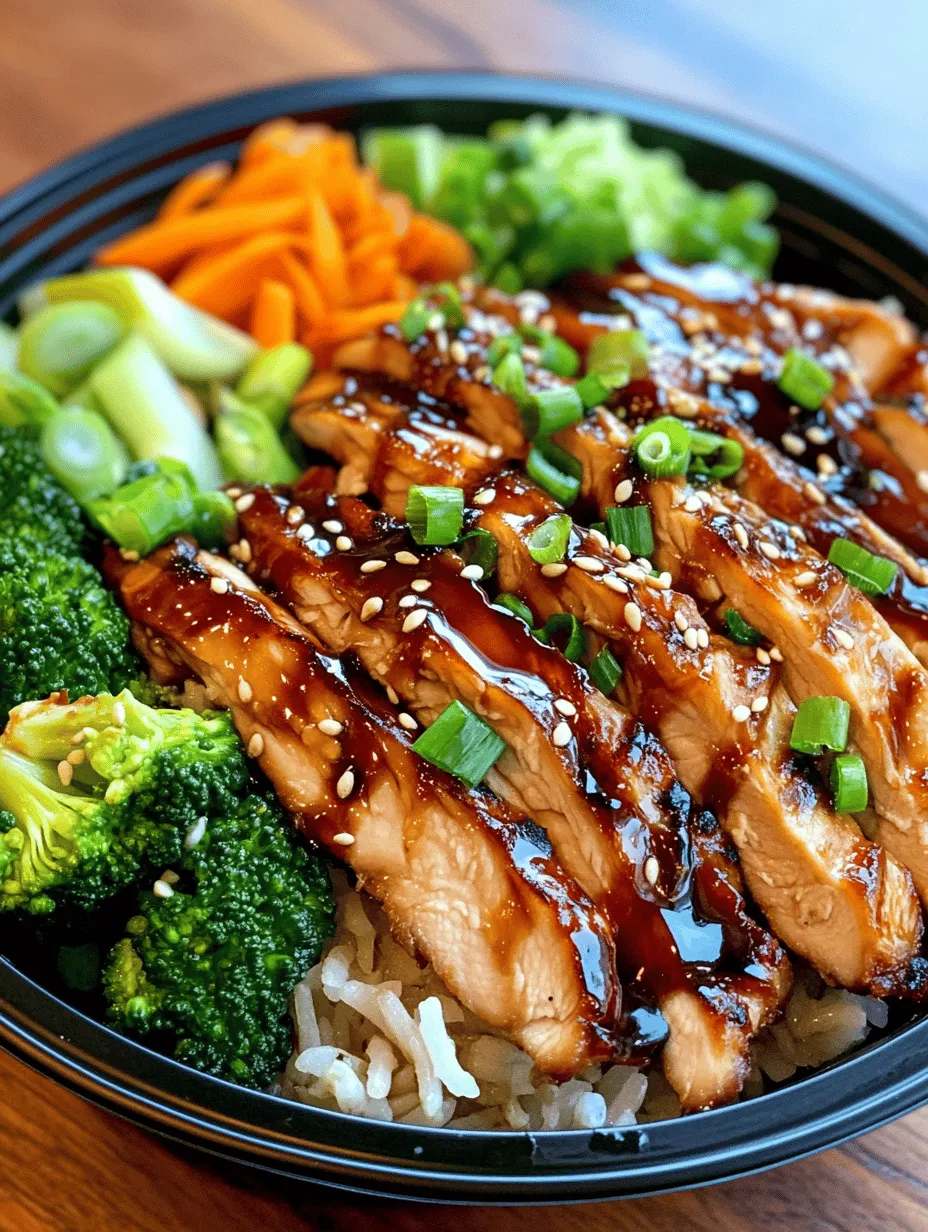Introduction
The Teriyaki Chicken Rice Bowl is a delightful combination of tender chicken, aromatic rice, and vibrant vegetables, all drizzled with a sweet and savory teriyaki sauce. This dish not only satisfies the palate but also offers a nutritious meal option that can be prepared in under an hour. The harmony of flavors and textures in this bowl makes it a favorite across households and restaurants alike.
In this article, we will explore the origins of teriyaki cuisine, delve into the health benefits of the ingredients, and provide a comprehensive guide to crafting the perfect Teriyaki Chicken Rice Bowl at home. Whether you are a culinary novice or a seasoned cook, this recipe is sure to impress your family and friends, making it a perfect addition to your weeknight dinner rotation.
Understanding Teriyaki Cuisine
The Origins of Teriyaki
Teriyaki, a cooking technique that has become synonymous with Japanese cuisine, translates to “glaze broil.” The method involves grilling or broiling meat while applying a glaze made from soy sauce, sake, and sugar. The origins of teriyaki can be traced back to the 17th century in Japan, where it was initially a cooking method used for various meats. Over the centuries, it has evolved into a popular dish not just in Japan, but around the world.
Culturally, teriyaki holds a significant place in Japanese dining. It embodies the principles of balance and harmony that are central to Japanese cuisine. The combination of sweet and savory flavors, along with the glossy finish of the sauce, exemplifies the artistry of preparing food that is both visually appealing and delicious. Teriyaki has transcended its humble beginnings to become a staple in fusion cuisine, often adapted to local tastes and ingredients, making it approachable for everyone to enjoy.
The Health Benefits of Key Ingredients
Nutritional Value of Chicken
Chicken, especially boneless, skinless chicken breasts, is a primary ingredient in the Teriyaki Chicken Rice Bowl. It serves as an excellent source of protein, which is essential for muscle repair, immune function, and overall growth. One serving of chicken breast provides about 26 grams of protein while remaining relatively low in calories, making it a preferred choice for health-conscious individuals.
In addition to protein, chicken is rich in vital nutrients such as B vitamins (including niacin and B6), which play a crucial role in energy metabolism and brain health. By including chicken in your diet, you can enhance your nutritional intake while enjoying a dish that is both flavorful and satisfying.
The Power of Soy Sauce
Soy sauce is a key flavor component in teriyaki sauce, contributing its distinct umami taste. Made from fermented soybeans, soy sauce is rich in antioxidants and contains compounds that may support heart health and digestion. However, it is important to be mindful of sodium content, as traditional soy sauce can be high in salt.
For those watching their sodium intake, low-sodium soy sauce options are available and can be used without sacrificing flavor. Incorporating soy sauce not only enhances the taste of dishes but also provides a depth that complements the sweetness of the honey and the freshness of the vegetables.
The Sweetness of Honey
Honey serves as a natural sweetener in teriyaki sauce, providing a healthier alternative to refined sugar. It not only adds sweetness but also contributes a unique flavor profile that balances the saltiness of soy sauce. Nutritionally, honey is rich in antioxidants and has anti-inflammatory properties, making it a beneficial addition to your diet.
Using honey instead of sugar can enhance the overall healthiness of your Teriyaki Chicken Rice Bowl, allowing you to indulge in its sweetness without the negative effects associated with processed sugars.
The Importance of Vegetables
A colorful array of vegetables is often included in the Teriyaki Chicken Rice Bowl, providing essential nutrients and fiber. Common choices include broccoli, bell peppers, and snap peas, which not only add flavor and texture but also boost the nutritional value of the dish.
Broccoli, in particular, is a powerhouse of vitamins C and K, fiber, and various antioxidants. These nutrients are vital for maintaining a healthy immune system and promoting overall well-being. When selecting vegetables, aim for fresh, vibrant options, as they will enhance both the visual appeal and nutritional content of your meal.
Ingredient Breakdown for Teriyaki Chicken Rice Bowl
Essential Ingredients and Their Functions
To prepare a delicious Teriyaki Chicken Rice Bowl, it is crucial to use quality ingredients that work harmoniously together. Here’s a breakdown of the essential components:
– Chicken Breasts: The protein base of the dish, boneless and skinless chicken breasts are preferred for their lean texture and ability to absorb flavors from the marinade.
– Rice: The foundation of the bowl, you can choose between jasmine rice, known for its fragrant aroma, or traditional white rice, which offers a neutral base that pairs well with the teriyaki sauce.
– Marinade Components: The key to a flavorful teriyaki chicken lies in its marinade. Essential ingredients include soy sauce, honey, rice vinegar, sesame oil, garlic, and ginger. Each component contributes to the overall flavor profile, adding depth and complexity to the dish.
– Garnishes: Simple garnishes such as green onions and sesame seeds not only enhance the presentation but also add a burst of flavor and texture to each bite.
Preparation Steps for Teriyaki Chicken Rice Bowl
Cooking the Rice
Proper rice preparation is fundamental to achieving the perfect Teriyaki Chicken Rice Bowl. The choice of rice can significantly impact the dish’s texture and flavor. Here is a step-by-step guide to cooking your rice:
1. Rinse the Rice: Start by rinsing your rice under cold water. This step removes excess starch and prevents the rice from becoming overly sticky during cooking.
2. Measure the Water: For every cup of rice, you will need about 1.5 to 2 cups of water, depending on the type of rice you choose. Jasmine rice typically requires slightly less water than white rice.
3. Boil and Simmer: Bring the water to a boil in a saucepan, then add the rinsed rice. Stir briefly, cover, and reduce the heat to low. Allow the rice to simmer for about 15-20 minutes or until all the water is absorbed.
4. Let it Rest: Once cooked, remove the saucepan from heat and let it sit covered for another 5-10 minutes. This resting period allows the grains to firm up and ensures a fluffy texture.
5. Fluff the Rice: Finally, use a fork to fluff the rice before serving. This technique separates the grains and enhances the overall presentation of your Teriyaki Chicken Rice Bowl.
With the rice prepared, you are now ready to move on to marinating the chicken and assembling your dish. Stay tuned for the next section, where we will dive into the marinating process and cooking the chicken to perfection.

Tips for Achieving Fluffy Rice
The foundation of any great rice bowl is, of course, the rice. To ensure your rice is fluffy and perfectly cooked, start by selecting the right type of rice. Short-grain or medium-grain rice tends to yield the best texture for a teriyaki chicken rice bowl. Here are some tips to help you achieve that perfect fluffy texture:
1. Rinse the Rice: Before cooking, rinse the rice under cold water until the water runs clear. This process removes excess starch, which can cause the rice to become gummy.
2. Proper Water Ratio: The general rule of thumb is to use a 1:1.5 or 1:2 ratio of rice to water. For every cup of rice, use 1.5 to 2 cups of water, depending on how moist you prefer your rice.
3. Soaking: Soak the rice for 30 minutes before cooking. This allows the grains to absorb some water, leading to a more even cooking process.
4. Cooking Technique: Use a rice cooker for the best results. If cooking on the stovetop, bring the water to a boil, then reduce to a simmer and cover. Do not lift the lid during cooking, as this allows steam to escape.
5. Resting Period: After cooking, let the rice sit covered for about 10 minutes. This resting period allows the grains to firm up and absorb any remaining moisture.
Crafting the Teriyaki Marinade
The teriyaki marinade is key to infusing the chicken with rich flavors. Here’s a step-by-step guide to creating the perfect marinade:
1. Ingredients Needed:
– 1/2 cup soy sauce (low sodium is preferable)
– 1/4 cup mirin (Japanese sweet rice wine)
– 2 tablespoons brown sugar
– 1 tablespoon rice vinegar
– 1 clove garlic, minced
– 1 teaspoon fresh ginger, grated
– Sesame oil (optional for added depth)
2. Step-by-Step Guide:
– In a mixing bowl, combine the soy sauce, mirin, brown sugar, rice vinegar, garlic, and ginger. Whisk until the sugar is fully dissolved.
– If using, add a drizzle of sesame oil for an extra layer of flavor.
– Taste the marinade and adjust the sweetness or saltiness according to your preference. Adding more brown sugar will enhance the sweetness, while more soy sauce will boost the saltiness.
3. Tips for Enhancing Flavor with Additional Spices:
– Consider incorporating spices like black pepper or a dash of chili flakes for a hint of heat.
– A sprinkle of sesame seeds can add a nutty flavor to the marinade.
– Experiment with a splash of orange juice or zest for a citrusy twist.
Marinating the Chicken
Marinating is essential for maximizing flavor and tenderness in your chicken. Here’s how to do it right:
1. Best Practices for Marinating Chicken:
– Use boneless, skinless chicken thighs for juiciness, or chicken breasts for a leaner option.
– Cut the chicken into bite-sized pieces or leave them whole depending on your preference.
2. Recommended Marinating Times for Optimal Flavor:
– For best results, marinate the chicken for at least 30 minutes. However, for deeper flavor penetration, aim for 2-4 hours. If time permits, marinating overnight in the refrigerator will yield the best flavor.
– Avoid marinating for more than 24 hours, as the texture of the chicken can begin to break down too much.
Cooking the Chicken
Once your chicken has marinated, it’s time to cook it. Here are techniques for grilling or pan-searing:
1. Techniques for Grilling or Pan-Searing:
– Grilling: Preheat your grill to medium-high heat. Remove the chicken from the marinade, letting excess marinade drip off. Grill for about 6-8 minutes on each side, until the internal temperature reaches 165°F.
– Pan-Searing: Heat a tablespoon of oil in a large skillet over medium-high heat. Add the marinated chicken and cook for 6-8 minutes, turning occasionally, until golden brown and cooked through.
2. How to Achieve the Perfect Glaze:
– In the last few minutes of cooking, brush the chicken with the reserved marinade to create a glossy finish. Allow the marinade to caramelize slightly for a richer flavor.
Thickening the Sauce
A thickened sauce enhances the teriyaki chicken’s flavor profile. Here’s how to achieve the perfect consistency:
1. Explanation of Cornstarch Slurry and Its Purpose:
– A cornstarch slurry is a mixture of cornstarch and cold water used to thicken sauces. It’s a quick and effective method to achieve the desired thickness without altering the flavor.
2. Tips for Achieving the Right Consistency:
– To make a slurry, combine 1 tablespoon of cornstarch with 1 tablespoon of cold water. Mix until smooth, then gradually add it to your teriyaki sauce while stirring over medium heat.
– Allow the sauce to simmer for a few minutes until it thickens. If it becomes too thick, you can add a splash of water or more soy sauce to adjust the consistency.
Serving Suggestions
Plating your Teriyaki Chicken Rice Bowl effectively can elevate your dining experience. Here’s how to present the dish attractively:
1. How to Present the Dish Attractively:
– Start by placing a generous scoop of fluffy rice in the center of a bowl.
– Arrange the sliced teriyaki chicken on top of the rice, allowing the glaze to drizzle down.
– Add steamed vegetables such as broccoli, carrots, or bell peppers around the chicken for a colorful presentation.
2. Suggestions for Accompanying Sides:
– Serve with a side of edamame or a simple cucumber salad dressed with rice vinegar.
– A miso soup can also complement the meal, adding warmth and depth to the dining experience.
Garnishing for Flavor and Aesthetics
Garnishing enhances both the flavor and appearance of your dish. Here’s how to do it:
1. Importance of Garnishing:
– A well-garnished dish not only looks appealing but also adds layers of flavor. Fresh herbs and toppings can elevate the overall experience.
2. Ideas for Additional Toppings:
– Top your rice bowl with sliced green onions, sesame seeds, or a sprinkle of nori (seaweed).
– For an extra burst of flavor, consider adding pickled ginger or a drizzle of sriracha for heat.
Variations and Customizations
There are countless ways to customize your Teriyaki Chicken Rice Bowl to suit your preferences:
1. Exploring Alternative Ingredients:
– Substitute chicken with tofu for a vegetarian option, or shrimp for a seafood twist. Ensure to adjust cooking times accordingly, as shrimp cooks faster than chicken.
– Incorporate different vegetables such as snap peas, zucchini, or bok choy to add variety and nutrition.
2. Creating a Spicy Teriyaki Chicken Rice Bowl:
– For those who enjoy heat, add chili flakes or a splash of sriracha to the marinade before marinating the chicken.
– Balance the spice with sweetness by including a touch more brown sugar or honey in the sauce.
Conclusion
The Teriyaki Chicken Rice Bowl is not just a meal; it’s an experience that brings together the richness of flavors and the joy of home cooking. By understanding the origins and health benefits of each ingredient, and by following the detailed preparation steps outlined, you can create a dish that is both satisfying and wholesome. Enjoying this bowl of goodness can be a delightful addition to your weekly meal rotation, offering a taste of Japan right in your kitchen. Whether you’re feeding your family or impressing guests, this recipe is sure to please. Embrace the art of cooking and the joy of sharing this delicious meal with those you love.



